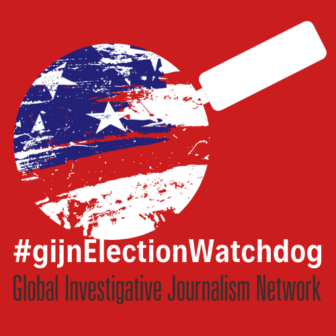
Update: In 2022, GIJN published an elections guide with four chapters. You can read it here.
It’s fair to say that the United States has never seen an election quite like this one. On November 3, Americans will vote to elect a president, members of the US Senate and House of Representatives, and thousands of local and state officials. There are concerns about armed poll watchers being sent to US polling stations to intimidate voters or interfere with mail-in ballots, charges of rigged voting and foreign interference, and record amounts of funding by donors, both open and covert. There is race-baiting, fear-mongering, and a tidal wave of disinformation — all amid a once-in-hundred-year pandemic. The stakes, not just for the United States but for the rest of the world, are enormous.

Top photo credit: Milan M. / Shutterstock. Above graphic design: Cora Moyano / GIJN.
For what remains of this extraordinary election season, GIJN is turning its global focus to the United States. We’ve surveyed a vast array of resources and done what we do for journalists around the world: selected those tips and tools we think will be most useful for reporters on the front lines.
We’re following up with a daily stream of updates which you can follow on Twitter at #gijnElectionWatchdog and in Spanish at #gijnLupaElectoral. Have an addition or update? Email us at ElectionWatchdog@gijn.org.
We’ll be adding great resources for the 2022 elections here:
Politician Parade Twitter: Helps you find Congressional Representatives in Twitter Space
Politician Parade Google News: Find Congressional Representatives in Google News
Here’s our roundup of the best resources for Election 2020:
Speeches, Transcripts, Tweets, and Videos
Analysis, Polls, and Roundups
GIJN’s ElectionWatchDog compiles useful tips and tools for reporters.
New from First Draft is their US 2020 Dashboard: Live insights on disinformation, updated daily.
University of Florida Professor Michael McDonald tracks and analyzes 2020 general election early vote statistics.
Cook Political Report is an independent and nonpartisan team of election experts who cover US elections and political trends. Their site offers free and subscription-only content.
FiveThirtyEight, named after the number of electors in the US electoral college, is as wonky as the name implies. But the team does smart political roundups and is the go-to site for polling aggregation.
ProPublica’s Electionland2020 is a collaborative journalism project that covers voting access, cybersecurity, misinformation, and election integrity in the 2020 elections.
The Associated Press (AP), an independent news cooperative, has a reporter in every statehouse and provides daily on-the-ground election coverage.
Campaign Finance
The Center for Responsive Politics (CRP) is a nonpartisan research group that tracks money in US politics and its effect on election and public policy. Their website, OpenSecrets, is the go-to source for federal campaign contributions, lobbying data, and analysis.
CRP’s Learning Center offers the basics of campaign finance with tips, tools, and timelines; the Center tracks federal campaign contributions to local elections; and its newsroom provides analysis on local and national politics.
The National Institute on Money in Politics (NIMP) slices and analyzes campaign finances with its Follow the Money project.
ProPublica’s FEC Itemizer makes it easy to browse electronic campaign finance filings from the Federal Election Commission (FEC), including filings by day, or by committees, races, super PACs, and more.
And the source of all that campaign finance data is the FEC. It’s the regulatory agency charged with administering and enforcing federal campaign finance law.
For details on campaign finance data and rules at the US state level, check the National Conference of State Legislatures (NCSL) Disclosure and Reporting Requirements, and The Campaign Finance Institute’s links to official state agencies and disclosure reports.
Advertising Expenditures
Want to check for ad spending? CRP tracks that too. Follow how much is spent online on Facebook and Google, and on television and radio with its political ads trackers.
Political advertising expenditure data can be purchased from commercial vendors like Kantar Media, Advertising Analytics, or Media Monitors. Advertising Analytics gives regular free updates on its Twitter feed.
Ad expenditures are also available free from the Public Inspection Files of the Federal Communications Commission (FCC), and the FEC campaign finance data, but in formats that make it nearly impossible to analyze in the aggregate. To find ad spending in FEC data, just go to the spending tab, choose “disbursements,” and filter by “advertising.”
In addition to tracking the amount of money spent on online ads, it’s also important to understand how or whether that information is regulated, and the policies that platforms like Facebook, Google, Reddit, Snapchat, and Twitter have in place.
You can find incisive reports on political ads on the big social media platforms from Digital Politics at The Center for Information, Technology, and Public Life (CITAP). Check Platform Advertising and Political Ad Database Comparisons.
The Election Integrity Partnership reviewed the election-related misinformation and disinformation policies of 14 different social media platforms, with links to the policies and analysis of their efficacy.
The non-partisan Wesleyan Media Project (WMP) analyzes volume, spending, sponsorship and content of political advertising.
The NYU Online Transparency Project recently launched the Ad Observatory, a tool that brings more functionality than Facebook’s Ad Library provides. Drill down by state, search trends, set up notifications.
Google’s Political advertising library is part of its Transparency Report, and is generally updated daily. See its FAQ on political advertising about what’s included there.
Facebook’s Ad Library Report can be searched in multiple ways, including spending by candidate, advertiser, and location.
Fake News and Fact-Checking
The Poynter Institute’s Politifact quickly verifies or debunks assertions made by candidates or viral posts on social media.
FactCheck.org is a project of the Annenberg Public Policy Center of the University of Pennsylvania and, like Poynter, evaluates claims made in headline-grabbing interviews, speeches and assertions during US elections.
Factually, the weekly newsletter from the American Press Institute’s fact checking and accountability journalism project, also investigates issues ripe for misinformation.
Graphika has a specialized team focused on electoral integrity and disinformation detection; see their published reports and data here.
First Draft’s Infotheque2020 provides a primer for journalists on US election misinformation, and offers a Basic Toolkit and other Verification resources for newsrooms. Also useful: First Draft’s guide to covering cyber incidents, attribution.news, including phishing, hacking, and misinformation.
On verification generally, don’t miss DataJournalism.com’s Verification Handbook, Bellingcat’s Online Investigation Toolkit, and Craig Silverman’s Verification and Digital Investigations Resources.
Election Coverage How-To’s
Nieman Reports and Nieman Lab are publishing stories exploring how newsrooms are covering the U.S. elections.
For press safety, see the Committee to Protect Journalists (CPJ) resources to safely cover the 2020 US elections.
The Stanford Cyber Policy Center’s How to Responsibly Report on Hacks and Disinformation includes a full report and 10 Guidelines for reporting on propaganda.
Political communication scholars offer these recommendations to journalists covering the 2020 U.S. election.
American Press Institute (API) supports election programs that connect newsroom leaders, implement innovative election coverage, provide tips for covering election misinformation, and critically evaluate conspiracy theories.
API’s Trusted Elections Network issues the must-have “Guide to Covering Elections and Misinformation.” Also see API’s four-part report entitled “Getting it Right: Strategies for truth-telling in a time of misinformation and polarization.”
A former elections official offers these 8 tips for covering the US elections. Through them all runs this common thread: educate yourself on election processes, know the rules, and stay up to date.
ProPublica produced a handy reporting guide on mail-in voting, full of practical tips and background.
Poynter offers this pre-election guide to reporting on the weirdest election ‘night’ ever: 14 questions for journalists to answer before Election Day to prepare for delays in projections.
Election Security
The Brennan Center for Justice special projects on Election Security outlines the vulnerabilities in US voting systems, with recommended solutions and contacts for election experts. They also have a breakdown of steps election officials should be taking to ensure safe voting. Use it to gauge your local officials’ preparedness.
The Cybersecurity and Infrastructure Security Agency (CISA), Election Infrastructure Security.
The U.S. Election Commission’s (EAC) Election Security Preparedness reports and studies.
National Conference of State Legislators (NCSL) election security: state policies.
National Public Radio’s special series on election readiness is a good way to keep abreast of new developments.
Verified Voting’s Voting Machine Verifier lists polling machine equipment down to the state and county levels, from 2006-2020. Their Voting Equipment Database details the types of voting equipment in use.
The New York Times convened a panel of security experts to discuss their seven election day nightmares, and what to do about it.
Election Explainers
Journalist’s Resources offers this explainer: The Electoral College: How America picks its president.
The Massachusetts Institute of Technology’s Election Data + Science Lab (MEDSL) is a terrific clearinghouse for Election Explainers (modes of voting, access to ballots, managing the process of voting); Election Datasets and Tools; and Election Experts.
FiveThirtyEight looked at the changes in the electoral map over time (under the US election system, a candidate can win the popular vote, but still lose the election).
In this frequently updated interactive by The New York Times, each state is represented by its current Cook Political Report rating, which gauges the likelihood either candidate will win the state’s electoral votes.
The Washington Post looks at possible shifts in turnout and voting patterns to anticipate how Trump or Biden fare in the election, and includes a list of their data sources at the end of the piece.
Legal Issues and Dirty Tricks
The Brennan Center for Justice’s report on Digital Disinformation and Vote Suppression lays out the challenges the US elections face in 2020. The Center lists potential tactics that may be used to suppress or intimidate voters, and dirty tricks to be on the lookout for.
The NCSL newsletter, The Canvass, reviews ongoing litigation associated with the 2020 election. It highlights four flashpoints: all-mail elections, absentee ballot eligibility and applications, witness requirements, and how ballots can be returned.
The Healthy Elections Project from Stanford-MIT, created an election litigation tracker, a database that tracks COVID-related election law cases. The Brennan Center updated their Voting Rights Litigation 2020 tracker on September 22, 2020.
Know the rules: the William & Mary Law School and the National Center for State Courts created eBenchbook, a searchable database of state election codes and supplementary election law materials.
Georgetown Law’s Institute for Constitutional Advocacy and Protection (ICAP) created 50 State Fact Sheets explaining laws on unauthorized private militia groups.
The nonprofit, nonpartisan Campaign Legal Center works on campaign finance, voting rights, redistricting, and government ethics.
The Reporters Committee for Freedom of the Press has created a legal guide to help journalists understand their rights at polling locations, and while covering the election.
Speeches, Transcripts, Tweets, and Videos
Campaign and election videos and Campaign 2020 archives are keyword searchable, and available on C-SPAN, the public-service cable network.
Talk2020 from The Wall Street Journal and Dow Jones’s Factiva, is a collection of selected transcripts searchable by issue or free text search.
The Internet Archive offers a free, searchable database of TV news programs and more. The text is taken from closed caption, so check against the video for accuracy.
See also Vote Smart, which tracks candidate positions, voting records, and public statements.
President Trump uses Twitter as a primary means of communication, so while sources like the Compilation of Presidential Documents are official government records, check the Trump Twitter Archive and Factbase’s deleted tweets for more from Trump.
Voter Data
Campaigns, news organizations, and others use extensive voter registration data like this aggregated set from L2 Political to find and target people based on demographic data. It’s also available from other commercial vendors like LexisNexis; pricing depends on a variety of factors.
Voter registration lists are public records that any citizen can obtain; find out what each state makes available, and to whom, here, from the NCSL.
Contact state or local election officials for specific information on what detail is included with voter registration data, and lists of polling places, ballot measures, election laws, and more.
The Pew Research Center’s Election 2020 analyzes the Changing Racial and Ethnic Composition of the U.S. Electorate.
Voting Rights and Rules
US national elections are essentially local productions. Responsibility for administering elections is up to individual states and territories, and no two states do it exactly the same way.
The National Conference of State Legislatures (NCSL) produces a continuously updating stream of information on voter ID requirements, voting centers, dates absentee ballots are mailed out, dates when counting can begin, and more. They also maintain a searchable database of State Elections Legislation.
Combine that with the list of resources from the National Association of State Election Directors (NASED) and the National Association of Secretaries of State (NASS) Can I Vote website, and you’ll have what you need to understand US election related policies, procedures, and technologies.
NASS frequently updates election administration surveys on absentee voting dates, canvassing timelines, state laws on elections and more.
U.S. Election Commission has resources for voters and election officials, and a wide variety of election related reports, studies and data.
The Associated Press’s (AP) interactive map on advance voting lists rules for each state, and a frequently updated tally on the number of absentee ballots sent and returned.
The ACLU’s Let People Vote site makes it easy to find voting registration dates, details and more for each state.
The US Vote Foundation lists services for absentee ballot requests and voter registrations for US voters at home and abroad.
And the National Vote at Home Institute works with election officials and advocacy groups to help expand voting by mail systems in every state.
Voting Results
The Associated Press (AP) tabulates the outcome of nearly every US state and national primary, general election, and referendum. Here’s how they do it.
The AP also explains how the pandemic is affecting this year’s election, and how they declare winners.
In the days and possibly weeks after election day, follow their breaking news election results on Twitter: #APracecall.
With expected heavy absentee voting in the 2020 election, delays in election reporting are likely. Read more in Fair Elections During a Crisis from the University of California, Irvine School of Law, including recommendations to ensure legitimacy.
This Congressional Research Service report, The Electoral College: A 2020 Presidential Election Timeline, explains the lead up to November 3, and all the deadlines, rules, and scenarios for what happens after votes are cast, including challenges to vote returns.
What might happen after Election Day in the event of contested results is being analyzed from legal and political perspectives.
NCSL compiled the rules each state has for automatic recounts, in the case of close elections.
A comprehensive analysis comes from Edward B. Foley, an Ohio State University law professor: Preparing for a Disputed Presidential Election: An Exercise in Election Risk Assessment and Management.”
Harvard Law School Professor Cass R. Sunstein outlines what roles the US Constitution, Electoral College, Congress, and Vice President play when the vote is close and people disagree who won: “Post-Election Chaos: A Primer.”
Law Professor Richard Hasen discusses his book, Election Meltdown: Dirty Tricks, Distrust and the Threat to American Democracy in this January 2020 interview with NPR’s Terry Gross.
 This guide was assembled by GIJN Resource Center Director Lynn Dombek, with help from Toby McIntosh and the GIJN staff. Lynn has spent 30 years working with and leading research teams in the national headquarters of NBC News, ABC News, Time Inc., and the Associated Press, where she was its research director for 10 years.
This guide was assembled by GIJN Resource Center Director Lynn Dombek, with help from Toby McIntosh and the GIJN staff. Lynn has spent 30 years working with and leading research teams in the national headquarters of NBC News, ABC News, Time Inc., and the Associated Press, where she was its research director for 10 years.